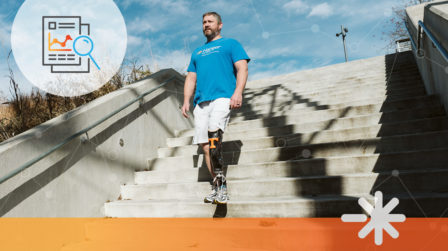Up-to-date information about Hanger Clinic’s response
Types of Prosthetic Feet
A number of different types of prosthetic feet are available to meet the differing needs of individuals with lower limb amputation. While most prosthetic feet belong to one of the major categories listed below, there are also prosthetic feet that combine characteristics and functionality across multiple classes of feet. Your clinician will evaluate your specific needs and activities and will help you decide which option is best for you.
Learn more about each type of technology below.
Hydraulic Ankle Feet
Hydraulic ankle feet allow resisted movement of the prosthetic foot at an adjustable hydraulic ankle joint. This allows for walking with greater stability, accommodates walking across a greater range of surfaces and environmental obstacles, and may reduce localized socket pressure points for some patients.
Microprocessor Feet
Microprocessors change the resistance of the prosthetic ankle in real time based on your walking speed, the incline or decline of a slope, and type of terrain. Patients also have suggested increased socket comfort and reduced stumbles and falls with this developing technology.
Powered Feet
Powered feet utilize battery power to mimic the powered propulsion of the foot and ankle muscles. These feet are generally comparatively heavy and require daily battery charging. However, appropriate patients have reported decreased fatigue with the use of this technology.
Dynamic Response Feet
Dynamic response feet store energy throughout each step through the deformation of their carbon structures. These structures return to their original shape at the end of each step, resulting in a return of the stored energy, as well as a more natural, fluid gait.
Axial Feet
Single-axial feet mimic the movement of the ankle joint by allowing movement at a mechanical ankle joint. They provide stability, are generally recommended for more reserved walkers, and can be especially valuable for patients with poor knee control or patients attempting limited walking with an above-knee prosthesis. Multi-axial feet allow dampened movements of the foot in several planes, which helps increase stability and comfort on non-level surfaces.
Solid Ankle Cushion Heel (SACH)
SACH feet are a lightweight, basic prosthetic option optimal for light activity.
Partial Feet and Toes
Partial foot and toe solutions can improve stability, help shoes fit, and offer cosmetic restoration.
Request a Free Evaluation
Learn more about your prosthetic feet options by scheduling a free consultation at a Hanger clinic near you.



